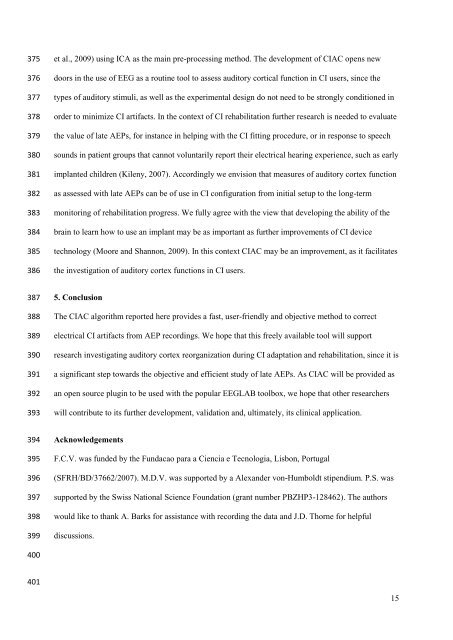Elsevier Editorial System(tm) for Hearing Research Manuscript Draft ...
Elsevier Editorial System(tm) for Hearing Research Manuscript Draft ...
Elsevier Editorial System(tm) for Hearing Research Manuscript Draft ...
Create successful ePaper yourself
Turn your PDF publications into a flip-book with our unique Google optimized e-Paper software.
375<br />
376<br />
377<br />
378<br />
379<br />
380<br />
381<br />
382<br />
383<br />
384<br />
385<br />
386<br />
387<br />
388<br />
389<br />
390<br />
391<br />
392<br />
393<br />
394<br />
395<br />
396<br />
397<br />
398<br />
399<br />
400<br />
401<br />
et al., 2009) using ICA as the main pre-processing method. The development of CIAC opens new<br />
doors in the use of EEG as a routine tool to assess auditory cortical function in CI users, since the<br />
types of auditory stimuli, as well as the experimental design do not need to be strongly conditioned in<br />
order to minimize CI artifacts. In the context of CI rehabilitation further research is needed to evaluate<br />
the value of late AEPs, <strong>for</strong> instance in helping with the CI fitting procedure, or in response to speech<br />
sounds in patient groups that cannot voluntarily report their electrical hearing experience, such as early<br />
implanted children (Kileny, 2007). Accordingly we envision that measures of auditory cortex function<br />
as assessed with late AEPs can be of use in CI configuration from initial setup to the long-term<br />
monitoring of rehabilitation progress. We fully agree with the view that developing the ability of the<br />
brain to learn how to use an implant may be as important as further improvements of CI device<br />
technology (Moore and Shannon, 2009). In this context CIAC may be an improvement, as it facilitates<br />
the investigation of auditory cortex functions in CI users.<br />
5. Conclusion<br />
The CIAC algorithm reported here provides a fast, user-friendly and objective method to correct<br />
electrical CI artifacts from AEP recordings. We hope that this freely available tool will support<br />
research investigating auditory cortex reorganization during CI adaptation and rehabilitation, since it is<br />
a significant step towards the objective and efficient study of late AEPs. As CIAC will be provided as<br />
an open source plugin to be used with the popular EEGLAB toolbox, we hope that other researchers<br />
will contribute to its further development, validation and, ultimately, its clinical application.<br />
Acknowledgements<br />
F.C.V. was funded by the Fundacao para a Ciencia e Tecnologia, Lisbon, Portugal<br />
(SFRH/BD/37662/2007). M.D.V. was supported by a Alexander von-Humboldt stipendium. P.S. was<br />
supported by the Swiss National Science Foundation (grant number PBZHP3-128462). The authors<br />
would like to thank A. Barks <strong>for</strong> assistance with recording the data and J.D. Thorne <strong>for</strong> helpful<br />
discussions.<br />
15
















